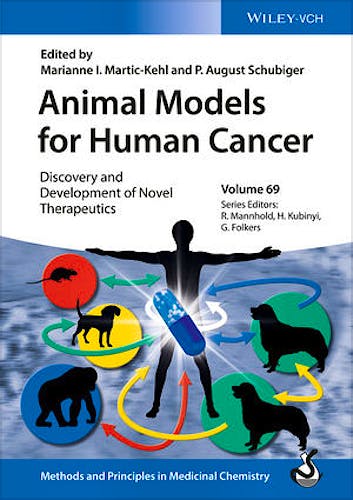

No hay productos en el carrito



Animal Models for Human Cancer: Discovery and Development of Novel Therapeutics
Martic-Kehl, M. — Schubiger, P. — Mannhold, R. — Folkers, G. — Buschmann, H.
1ª Edición Julio 2016
Inglés
Tapa dura
248 pags
1000 gr
21 x 28 x null cm
ISBN 9783527339976
Editorial WILEY
LIBRO IMPRESO
-5%
151,98 €144,38 €IVA incluido
146,13 €138,83 €IVA no incluido
Recíbelo en un plazo de
2 - 3 semanas
LIBRO ELECTRÓNICO
-5%
135,19 €128,43 €IVA incluido
129,99 €123,49 €IVA no incluido
Acceso On Line
Inmediato
Description
Based on results from the past ten years, this ready reference systematically describes how to prepare, carry out, and evaluate animal studies for cancer therapies, addressing the widely recognized lack of reliable and reproducible results. Following a short historical introduction and a discussion of the ethics surrounding animal experiments, the book describes correct study design as well as the handling and housing of animals. It then goes on to describe the animal models available for different cancer types, from natural cancer models in mice and dogs to humanized animals. An evaluation of previously unpublished long-term data from the Swiss canine and feline cancer registry is also included. The final part of the book reviews the lessons learned over the last decade on how to interpret data from animal studies for improving human therapy and gives recommendations for future drug development.
Contents
Preface
INTRODUCTION
ETHICS IN ANIMAL RESEARCH
Introduction
Today's R&D Environment
"Do no Harm" -
The Essential Dilemma of Animal Research
Man and Animals in Philosophy -
An Overview of Key Concepts
Conclusions -
Solving the Dilemma
STUDY DESIGN
Introduction
Design Principles
Experimental Design
Conclusion
IMPROVING EXTERNAL VALIDITY OF EXPERIMENTAL ANIMAL DATA
Introduction
Variation in the Laboratory
The Fallacies
Future Perspectives: An Experimental Strategy Integrating Adaptive Plasticity and Fundamental Methodology
HOW TO END SELECTIVE REPORTING IN ANIMAL RESEARCH
Introduction
Definition and Different Manifestations of Reporting Bias
Magnitude of Reporting Biases
Consequences
Causes of Reporting Bias
Solutions
A COMPREHENSIVE OVERVIEW OF MOUSE MODELS IN ONCOLOGY
Why Mouse as Models of Cancer
What is a Good Mouse Model of Cancer
What are the Tools for Making One
Humanized Mice: Why Humanized Mice
Mouse Models for Immunological Research in Oncology
Applications and Limitations of Mouse Models of Cancer: Strategies and Accomplishments for Producing Complicated Models in Mouse: Other Mouse Models
Potentials, Limitations, and Future Directions for Mouse Models in Oncology Drug Development: In the Time of Personalized Medicine
How can we Improve them for Cancer Drug Development: With Particular Stress on the Different Phases of Drug Development
MOUSE MODELS OF ADVANCED SPONTANEOUS METASTASIS FOR EXPERIMENTAL THERAPEUTICS
Mouse Tumor Models in Cancer Research
The Evolution of Metronomic Chemotherapy
Development of Highly Aggressive and Spontaneously Metastatic Breast Cancer Models
Is There any Evidence that Models of Advanced Metastatic Disease have the Potential to Improve Predicting Future Outcomes of a Given Therapy in Patients?
Metronomic Chemotherapy Evaluation in Preclinical Metastasis Models
Experimental Therapeutics using Metastatic Her-2 Positive Breast Cancer Xenograft Models
Examples of Recently Developed Orthotpic Models of Human Cancers
Factors that can Affect the Usefulness of Preclinical Models in Evaluationg New Therapies
Monitoring Metastatic Disease Progression in Preclinical Models
Alternative Preclinical Models -
PDX and GEMMs
Recommendations for the Evaluation of Anti-Cancer Drugs Using Preclinical Models
Summary
SPONTANEOUS TUMOR ANIMAL MODELS
Introduction
Advantages of Spontaneous Canine /
Feline Cancer Registries
Spontaneous Animal Tumors as Suitable Models for Human Cancers
The Swiss Canine /
Feline Cancer Registry 1955-2008
Conclusion
DOG MODELS OF NATURALLY OCCURRING CANCER
Introduction
Advantages of Spontaneous Cancer Models in Dogs
Dog Cancer Models
Preclinical and Vetinary Translational Investigations in Dogs with Cancer
Necessary Developments for Realizing the Potential of Canine Models
Key Challenges and Recommendations for Using Canine Models
Conclusions
IMPROVING PRECLINICAL CANCER MODELS: LESSONS FROM HUMAN AND CANINE CLINICAL TRIALS OF METRONOMIC CHEMOTHERAPY
Introduction: Low-Dose Metronomic Chemotherapy
Clinical Trials of Metronomic Chemotherapy
Veterinary Metronomic Trials in Pet Dogs with Cancer
Lessons Learned from Clinical Trials: Improving the Predictability of Preclinical Models
Conclusions
Author Information
Marianne Martic is a senior assistant at the Transdisciplinary Laboratorium Collegium Helveticum, a joint institution of the Swiss Federal Institute of Technolgy(ETH) and the University of Zurich (UZH). She joined the institution after obtaining her degree at the radiopharmaceutical institute of ETH Zürich, where she has worked on animal experimental protocols in the field of positron emission tomography (PET). Her current research is focused on the systematic reviewing and meta-analysis of preclinical animal experiments.
August Schubiger is a senior fellow at the Transdisciplinary Laboratorium Collegium Helveticum, a joint institution of ETH and UZH. He has been full Professor ofRadiopharmacy at the Institute of Pharmaceutical Sciences at ETH Zurich and headed the Center for Radiopharmaceutical Science of the ETH, the Paul ScherrerInstitute (PSI) and at the Clinic and Polyclinic for Nuclear Medicine at the UZH until 2010. He is currently involved in the project 'Drug development - significance and predictive value of animal testing'.
© 2025 Axón Librería S.L.
2.149.0